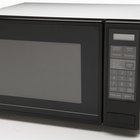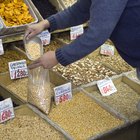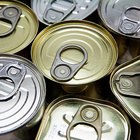IriGri8/iStock/GettyImages
How long leftovers can safely stay in your refrigerator depends on the type of food and whether or not your fridge is truly keeping foods cold. It certainly saves you time and money to use leftover vegetables in a pasta or soup the next day, or leftover steak in a green salad. Err on the side of caution and safety, however, when dealing with leftovers in your fridge.
Do It Right
Leftovers stay safe only if you follow safety guidelines. Ensure that your fridge is between 32 and 40 degrees Fahrenheit. If the leftovers have already been out of the fridge for longer than two hours, err on the side of safety and toss them out. Place hot leftovers, such as soups or chilis that have been simmering on the stove, into shallow containers so they will cool within the two-hour safety period. Don't worry about putting hot foods in the fridge; you won't harm your refrigerator by doing so and you will cool the food more quickly.
Eat These Soon
Most leftover foods, including cooked meats, pizza, soups, stews, vegetables and stir-fries, last from three to four days in the refrigerator, according to the U.S. Food and Drug Administration. Foods that you or others have eaten directly from the jar or carton, such as baby food or cartons of Chinese food, are safe for only two to three days, because traces of saliva can promote bacteria growth. Make a habit of removing food to a separate container for eating if you plan to refrigerate the leftovers.
Long-Lasting Leftovers
Some leftovers can last for almost a week in the refrigerator. Tomato-based pasta sauces, for instance, are so acidic that they last as long as five days once they are opened. Either frosted or unfrosted cakes also are safe for five days. Cover a cake with foil to avoid aromas from other foods from penetrating the cake. Check used-by or expiration dates on all products and follow those guidelines to keep food safe.
Be Cautious
Despite the fact that refrigeration slows bacteria growth, some harmful bacteria may remain in leftovers. If you don't reheat food to at least 165 F, you may be at risk. Problems may occur when you reheat in the microwave, because cool spots might still exist in the foods. Minimize reheating problems by stirring the food halfway through heating and letting it sit for a minute or two so the residual heat is absorbed throughout the food.
Related Articles
How Long do Leftovers Last?

The Steps in Cooking Raw Foods in a ...

FDA Food Storage Temperature Guidelines

Can You Let Crock-Pot Meals Sit?

Does Canned Soup Go Bad?

Can You Cook Something Frozen in the ...

How Long Does Foil Keep Food Warm?
What Are the Dangers of Cooked Meat ...
How Long After the Expiration Date Can ...

Number of Times Food Can Be Reheated

What Are the Dangers of Plastic Bags ...

Can You Freeze Canned Goods?
Can You Cook Chicken Wings the Day ...

How to Cook Okra in the Microwave

How Long Can Meat Stay out of the ...

Dented Cans and Botulism

Is It Dangerous to Leave a Sandwich ...

How to Clean Burnt Spills on Silicone ...

How to Store Smoothies in the Fridge

Heating Foods in Plastic & BPA
References
- Foodsafety.gov: Handle Leftovers with Care
- Foodsafety.gov: Chill
- Foodsafety.gov: Storage Times for the Refrigerator and Freezer
- CBS News: How Long Foods Stay Fresh In Fridge
- U.S. Food and Drug Administration: Refrigerator Thermometers: Cold Facts about Food Safety
- Betty CRocker: SuperMoist Cake Mix Frequently Asked Questions
Writer Bio
Susan Lundman began writing about her love of cooking, ingredient choices, menu planning and healthy eating after working for 20 years on children's issues at a nonprofit organization. She has written about food online professionally for ten years on numerous websites, and has provided family and friends with homemade recipes and stories about culinary adventures. Lundman received her M.A. from Stanford University.